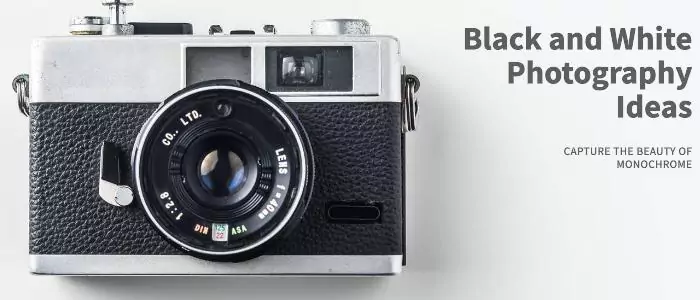Theodore Lowe, Ap #867-859
Sit Rd, Azusa New York
Find us here
Black and White Photography Ideas

Use natural light to create striking shadows and silhouettes in both landscape and portrait photography. Try varying the textures and patterns to create a visually arresting effect. Pay attention to body language and facial expressions to capture mood and emotion. Make use of the classic beauty of black and white photography to add depth and narrative to your pictures.
These pointers might improve your black and white picture shoot techniques and help you produce visually striking stories, whether you're a professional or an amateur enthusiast.
Choosing the Right Setting
Selecting the ideal location is essential for producing classic and alluring black and white images. Your choice of setting can intensify the atmosphere, give the composition more depth, and have a strong visual impact. We will go over a number of things to think about in this blog post while choosing the ideal location for your black and white photo session.
Indoor or Outdoor
Deciding whether to shoot indoors or outdoors heavily depends on the desired aesthetic and the story you want to tell through your photographs. Both options offer unique opportunities for creativity and expression.
- Indoor: It can be easier to control the lighting, backdrops, and objects in an indoor shoot, allowing you to create a certain mood. Indoor photo shoots let you concentrate on catching private and intimate moments, whether they take place in a studio, a house, or another local location. Try varying the patterns, textures, and furniture placements in your compositions to give them more visual appeal.
- Outdoor: On the other hand, outdoor photo shoots embrace the beauty of natural surroundings, showcasing the incredible play of light and shadow. Nature provides a wide range of backdrops, such as parks, gardens, beaches, or urban landscapes, which lend themselves well to diverse storytelling. Explore the richness of outdoor locations and utilize the elements of nature to enhance the contrast and tonal range in your black and white photographs.
Natural or Urban
Whether to choose an urban or nature venue for your black and white picture session is another crucial factor to think about. Each has a unique aesthetic appeal and emotion it conveys. Natural: Natural settings, such as forests, mountains, or lakes, offer a serene and organic backdrop for your black and white photographs. A feeling of peace, independence, and solitude can be evoked by the natural beauty of landscapes, leading to compositions that are engaging and tell stories of harmony and connection with nature. In order to give your vision more depth and emotion, make use of the serene lake, the softly curved ground, and the way the light falls through the trees.
- Urban: Conversely, urban environments have a different energy and can create a stark contrast in your black and white photographs. Capturing the raw and gritty atmosphere of the cityscape can bring out the characters and stories hidden within the bustling streets. Explore the lines, shapes, and textures of buildings, bridges, and streets to create dynamic black and white compositions that reflect the spirit and pulse of city life.
Consider the Lighting
Lighting is a crucial element in any photography, but it becomes even more important when shooting in black and white. Paying attention to the quality, direction, and intensity of light can make or break your photos.
- Natural Light: If shooting outdoors, consider the time of day and how it affects the quality of light. Early morning or late afternoon often offer soft, diffused light that adds a beautiful glow and gentle shadows to your subjects. Alternatively, bright midday sunlight can create high-contrast images with deep shadows and strong highlights, resulting in a more dramatic and dynamic effect.
- Artificial Light: For indoor shoots, experiment with different artificial lighting setups to create the desired mood and atmosphere. Whether it's using natural-light simulating LED bulbs, utilizing window light, or incorporating creative lighting techniques such as silhouettes or spotlights, the way you manipulate and control artificial light can greatly enhance the narrative and visual impact of your black and white images.
By carefully choosing the setting for your black and white photo shoot, you can create images that are truly captivating and evoke a wide range of emotions. Whether you decide to shoot indoors or outdoors, in natural or urban environments, always pay attention to the lighting conditions. Ultimately, the perfect setting will help you tell a compelling visual story that resonates with your audience.
Creating Contrast
Discover captivating black and white photo shoot ideas and essential tips to create striking contrasts. Unleash your creativity with these suggestions for stunning monochrome photography.
Creating Contrast Black and white photography is all about creating contrast, allowing the shades and tones to stand out. Playing with lighting, incorporating patterns and using props are key ways to achieve this. Let's explore some Black and White Photo shoot Ideas & Tips that focus on the concept of contrast.
Play With Lighting
When it comes to black and white photography, lighting is everything. Using dramatic lighting can emphasize the contrast between light and dark, creating stunning and impactful photos. Experiment with natural light, harsh shadows, or soft illumination to add depth and intensity to your images.
Incorporate Patterns
Patterns can enhance the contrast in black and white photo shoots. Incorporating bold and striking patterns, such as stripes or geometric shapes, can add visual interest and create a dynamic contrast within the composition. Patterns can also add texture and depth to the images, making them visually captivating.
Use Props
Props can make a significant difference in black and white photography. Whether it's a vintage chair, a bouquet of flowers, or even a classic hat, props can add depth, context, and a focal point to your photos. Utilize props creatively to enhance the contrast and create visually engaging compositions. In addition to these methods, experimenting with angles, exploring different perspectives, and emphasizing natural elements can also help in creating contrast in black and white photography. By incorporating these techniques, you can elevate your black and white photo shoots, making them distinctive and visually compelling.
Composition Techniques
Composition techniques are essential for creating captivating black and white photos. By understanding the principles of composition, photographers can enhance the visual impact and storytelling of their images. Here are some key composition techniques to consider for your black and white photo shoot.
Rule of Thirds
The rule of thirds is a fundamental concept in photography that involves dividing the frame into nine equal parts using two horizontal and two vertical lines. By placing key elements along these lines or at their intersections, photographers can create a well-balanced and visually appealing composition. This technique can add depth and interest to black and white photos, guiding the viewer's eye through the image with a natural flow.
Leading Lines
Leading lines are powerful compositional tools that draw the viewer's attention into the image. These lines can be actual physical lines, such as roads, pathways, or fences, or implied lines created by the arrangement of elements within the frame. When incorporated into black and white photos, leading lines can provide a sense of direction and movement, leading the viewer's gaze towards the focal point or subject of the image.
Symmetry and Balance
Symmetry and balance play a crucial role in black and white photography, as they contribute to the overall harmony and visual stability of the composition. Symmetrical compositions can create a sense of order and tranquility, while balanced asymmetry can add a dynamic and engaging quality to the image. When applying these techniques, photographers should carefully consider the placement of elements within the frame to achieve a harmonious and visually impactful result.
Posing and Expressions
Discover captivating black and white photo shoot ideas and essential tips for posing and expressions. Unleash the power of monochrome photography to convey emotions and create timeless images.
Experiment with Angles
When it comes to black and white photo shoots, experimenting with angles can add an interesting and unique touch to your photographs. By using different angles, you can create depth and dimension, making your images visually appealing. Try shooting from above or below the subject to change the perspective and highlight different features. Don't be afraid to get creative and think outside the box. By playing around with angles, you can capture captivating shots that stand out from the crowd.
Capture Genuine Emotions
In black and white photography, emotions can be portrayed even more powerfully. To make your photo shoot truly captivating, focus on capturing genuine emotions. Encourage your subject to express themselves naturally and authentically. Genuine laughter, a thoughtful expression, or a moment of contemplation can create stunning visual stories in black and white. Keep an eye out for those special moments when your subject's true emotions shine through, and be ready to capture them with your camera.
Focus On Body Language
Body language plays a crucial role in black and white photography. It can convey a range of emotions and add depth to your images. Pay attention to your subject's body language, as it can speak volumes in a monochromatic photograph. Encourage them to use different poses and gestures to convey different emotions or tell a story. Experiment with open and closed body positions, as well as subtle tilting of the head or shoulders, to add interest and dynamics to your shots. By focusing on body language, you can create compelling and visually engaging black and white images. To summarize, when it comes to posing and expressions in black and white photography, experimenting with angles, capturing genuine emotions, and focusing on body language are key. By doing so, you can create visually stunning photos that evoke emotion and leave a lasting impact on the viewer. So, don't be afraid to get creative, encourage your subjects to express themselves authentically, and pay attention to how their body language can enhance your images.
Post-processing Tips
Post-processing is an essential step in bringing out the best in your black and white photos. It allows you to refine the tonal range, adjust contrast and exposure, and add artistic elements to create stunning images that capture the viewer's attention. In this section, we will explore some useful post-processing tips and techniques that will help you take your black and white photography to the next level.
Adjusting Contrast and Exposure
One of the key aspects of post-processing black and white photos is fine-tuning the contrast and exposure. Correcting the contrast can enhance the visual impact and make your image more dynamic. Similarly, adjusting the exposure ensures that the light and dark areas are appropriately balanced, creating a well-exposed image. Here are some tips to consider:
- Use a histogram to guide your adjustments. The histogram provides a graphical representation of the tonal distribution in your image, helping you identify areas that are too bright or too dark.
- Experiment with different settings, such as curves or levels, to achieve the desired contrast. Increasing the contrast can make your subject pop, while reducing it can create a softer, more subtle look.
- Pay attention to the details in the highlights and shadows. Make sure you don't lose important details by overexposing or underexposing these areas.
Adding Grain or Texture
Adding grain or texture to your black and white photos can create a vintage or gritty effect that adds character and depth to your images. It can give them a nostalgic feel or make them stand out from the crowd. Here are some tips for adding grain or texture:
- Experiment with different tools or filters in your post-processing software to add grain or texture. Grain can be simulated to resemble the look of traditional film, while textures can be applied to specific areas of the image to enhance their visual impact.
- Adjust the grain or texture strength to achieve the desired effect. Be careful not to overdo it, as this can result in a noisy or distracting image.
- Consider the overall mood and style of your photo when adding grain or texture. Certain images may benefit from a subtle grain, while others may require a stronger textural element.
Enhancing Highlights and Shadows
Highlighting and controlling the highlights and shadows in your black and white photos can help bring out important details and tonal variations. This can enhance the three-dimensionality of your image and create a more visually appealing result. Here are some tips for enhancing highlights and shadows:
- Use adjustment layers or brushes to selectively enhance or reduce the highlights and shadows in your image. This allows you to have complete control over specific areas without affecting the overall tonal balance.
- Experiment with different blending modes and opacity settings to achieve the desired effect. Soft light overlay, and multiply are commonly used blending modes for enhancing highlights and shadows.
- Pay attention to the tonal transitions between the highlights and shadows. Ensure they are smooth and well-defined, providing a sense of depth and dimensionality to your photo.
Conclusion
Black and white photography is a timeless art form that allows for endless creativity and emotion. By following these black and white photo shoot ideas and tips, you can capture captivating images that tell a powerful story. From choosing the right setting to utilizing lighting and contrasting elements, each step plays a crucial role in achieving stunning results.
Related blog posts
How to Add Fonts in Photoshop: A Step-by-Step Guide
Are you ready to give your designs a unique twist? Adding new fonts in Photoshop can instantly elevate your creative projects, making them stand out with style and personality.


